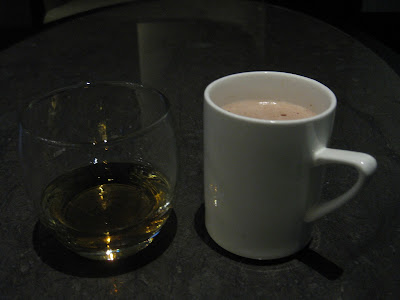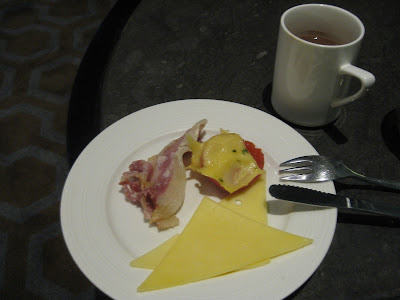10/26/2015
 |
| G'day to you too, Paddington! |
It's funny. I can never wake up at home, even if the alarm clock goes off right next to my ear. But in London, I set the alarm, yet always wake up at least half hour before it goes off. I'd gone to sleep at 3am this morning and set my alarm for 7, yet work up at 5:45am. Which turned out rather well, as last-minute packing gobbled up my time. I practically had to sit on my luggage to close 'em! My backpack was bulging at the seams (it was so heavy I almost fell backward when I first put it on), the carry-on 18kg, the check-in luggage 23kg on the dot.
Around 8am, I went over to Waitrose to return everything that couldn't fit in my luggage. I returned over 12 kg worth of stuff! Which sucks because all the baking goodies were 3-for-2 and damn, were they cheap! But it's not worth it to get dinged for overweight because those fees are mighty hefty!
Patricia took pity on me and helped me move my luggage to the Russell Square tube stop, which was super awesome of her. There was almost nobody at the station by 9am, so I could take my slow-ass time getting down the elevator, down a short flight of stairs and onto the train. The line goes directly to Heathrow, so I sat and enjoyed the scenery. It was bright and sunny out, the perfect end to my trip.
For a Monday morning, I did not experience the same heavy traffic my parents and Angel experienced last Monday morning when they headed back home. They said Heathrow was packed full of people and security took forever, but my wait wasn't long. Everything went smoothly and I was in the Plaza Premium lounge in no time, where I promptly ordered whiskey. And mocha. Then hot chocolate. Had myself a breakfast of:
I typed away on my laptop about the Wallace Collection, and before I knew it, an hour had already passed. Perfect. It's lunchtime! The buffet:
The chicken tikka masala was okay, but nothing to write home about. The chicken pesto was slightly better--even better when I added cubes of granular Cheddar cheese to it. To my surprise, I really enjoyed the English Trifle; the cake was super moist. I stuffed myself silly and after brushing my teeth, had to get everything together--thankfully, in the lounge, I had a big couch to spread everything out.
When I first checked in to get my boarding pass, I had a giant Primark bag with me carrying a hat, my big winter coat and basically everything I couldn't stuff inside my backpack and carry-on tossed into the bag. The check-in lady specifically told me I wasn't allowed a third item, so I had to put on the 100% wool hat, my very warm and effective winter coat, stuff as much stuff as I could into my jacket pockets...and then make my way over to the gate, which is a long 20 minute walk away from the lounge! They do have signs posted that the gate is very far away and to allow yourself plenty of time to get there, but typical me, I didn't believe it'd really take me that long.
Of course, I forgot I was toting the equivalent of a baby elephant on me. I was perspiring and all gross after walking all that way with my heavy-ass backpack and carry-on. They were already allowing people onto the flight when I arrived, and as I waited in line to go onto the plane, I kinda fell backward a bit and bumped into the man behind me. Sorry!
I was lucky in that when I arrived in my section of the plane, nobody else had yet arrived, so the overhead space was all empty. I heaved everything on top, plopped down in my seat...only for a man to tell me a few minutes later I was sitting in his seat. I NEVER do this! But I suppose I was so tired and flustered from the luggage, I was just relieved to fall down into a comfy chair. Luckily my seat was just across the aisle, so not too bad a hop.
The ride home was smooth and even though we took off 40 minutes late, we arrived 1/2 hour earlier than scheduled. SFO was a bitch though--typical SFO TSA employees, made me go through agriculture inspection. Will there ever be a time when I'm not picked??? >,< Honestly, I was the only one picked! The whole agriculture inspection area was empty except me!!! I seriously hate SFO.
Anyway, that's the end of our wonderful 2015 trip. The last week in London was like a dream, it was so amazing to go to all these museums and learn all the fascinating tidbits in history. I especially loved all the plays and musicals we went to, which brings me to...
Update 11/2/2015:
So. The whole time we were in London, Angel and I complained about how come Tom Hiddleston isn't doing theatre these days. We've seen a lot of our favorite British actors on stage, so how come Tommy Boy isn't doing any?
Turns out, he is. AND he's doing it right now. Every. Freakin. Night I was in London, he was on the goddamn stage! AND it's Shakespeare! Why why why didn't they do any promo??? I'm on the email list for pretty much all of London theatre--why didn't this play get any press??? I'm so pissed I missed him! There was one night I had nothing to do in London (well, besides packing, which ended up taking me 4 hours, but still); I could've SO gone to see him live! That would've totally rounded out my vacation; I would've been so so incredibly happy and ecstatic and floating on air...Argh! Why? Why? Whyyyyyy???
Angel tells me to stop pouting but I'm seriously considering flying back there right now (play ends 11/12). Haha I wish. Yes, I do wish!!!






















































